Lê Hương
After being impressed by the Vietnamese people living in northern Virginia in the US in the early 1990s, Charles Daniel Hambleton, a native of the state, visited Việt Nam for the first time.
“I was attracted to their sense of humour and liveliness, and a lot of things about the Vietnamese culture, including art and music,” Hambleton told Việt Nam News about who he chose to explore Vietnamese culture.
His first trip to Đà Lạt and Nha Trang in 1999 was only for about 10 days, but it was life-changing, and how he has had an exhibition of his paintings held at Exhibition House 16 Ngô Quyền Street, Hà Nội, that wraps up tomorrow.

Hambleton poses for a photo with a local in the southern province of Cần Thơ. Courtesy Photo of the artist
“I knew from that point on that I wanted to move here,” he recalled.
It took many years because of his responsibilities in the US, but the artist finally moved to Hà Nội in 2011 and has lived in the capital ever since.
He has tried various jobs to earn a living here including teaching English, writing and painting.
In a Post-Impressionist style with warm vivid colours, Hambleton's art shows the everyday people of Việt Nam like street vendors and popular scenes like small tea shops on street corners or noisy bia hơi (fresh beer) pubs.
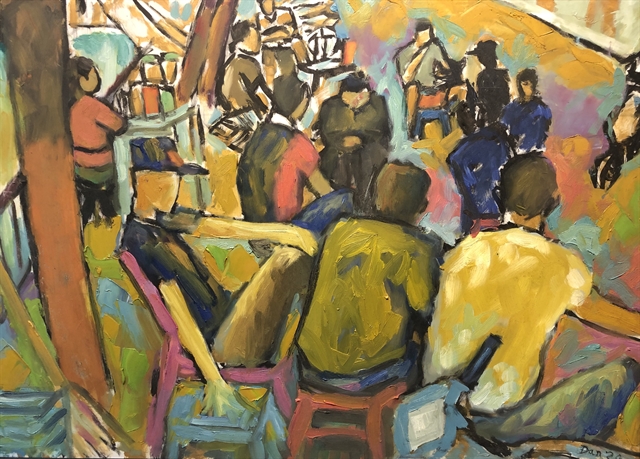
Tea drinkers in Bồ Đề Street 1, oil on canvas.
“Looking at his paintings, I am impressed with his Post-Impressionist style and beautiful colours,” commented painter Vũ Quang Huy, who works for the Military Cinema Studio.
“I think there are rarely any foreigners that draw Việt Nam with such poetic colours,” he added. “He must have a great love for the country and people.”
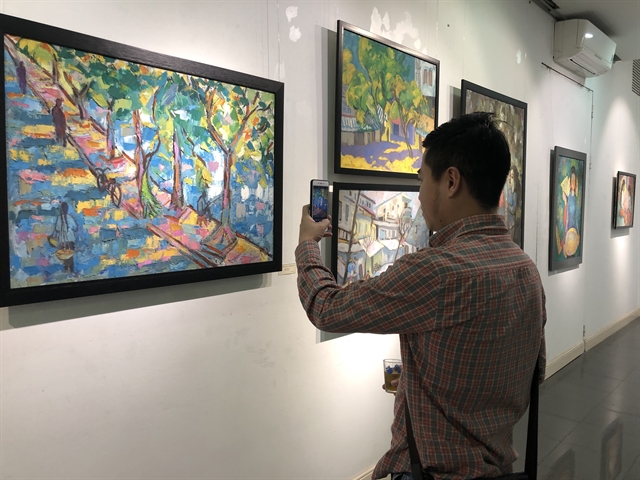
An audience visits Hambleton's exhibition last week in Hà Nội. VNS Photo Lê Hương
Hambleton said people can easily recognise specific streets or activities in his paintings.
“Because I’m a Westerner looking at the daily life of people in Việt Nam, a lot of very normal things are fascinating to me, and I try to show my feelings about them,” he said.
“I think that many painters and sculptors, or artists in any field - composers or writers and so on - usually feel something about the experience of life that they want to communicate,” he said. “Often what they end up with doesn’t achieve what they originally wanted, but at least they try.”
Hambleton said he thought the history of Việt Nam had influenced it in a unique way, but the people are like people all over the world.
“There might be behaviour that comes from cultural traditions and even some peer pressure, but I find that underneath what we’d call societal mores, people are always the same - they have the same desire to be happy, to enjoy friends and family, to have a safe place to live and satisfying work,” he said.
People love to laugh and also have a need to feel loved, he said.
Hambleton said he found people in the countryside were often more relaxed.
Having visited various places throughout the country, he said Việt Nam is beautiful with a lot of breath-taking landscapes.
“Riding my motorbike to places like Mù Cang Chải, Sa Pa and through Hà Giang Province has been a thrill,” he said. “I can do some sketching, but actually I’ve found that capturing the feeling of a beautiful mountain or beach scene is very difficult.”
“I agree with the line spoken in the movie called Dreams, by the famous Japanese director Akira Kurosawa, where the young Japanese painter meets Van Gogh sketching out in a field,” he said. “Van Gogh tells him: ‘A scene that looks like a painting does not make a painting.’ I think it’s true.”
Hambleton said that artists can't just copy beautiful landscapes as it might end up looking “pretty” and would be more commercially viable, without artistic integrity.
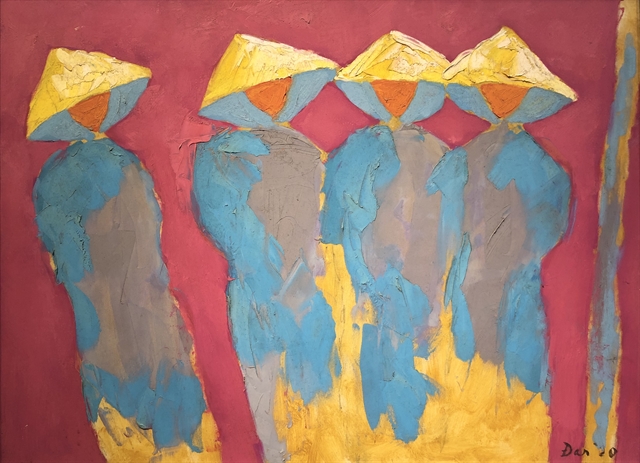
Four women in áo dài, oil on canvas, 60x80cm
“I think most serious Vietnamese artists and other artists would agree that more has to go into the creative process - the final product for many artists might even be an abstract painting, and somebody looking at it might say: ‘Oh yes, I see there’s a mountain in there.’"
One of the paintings that bring back strong memories is The Red Jacket: Village Girl in Northern Mountains.
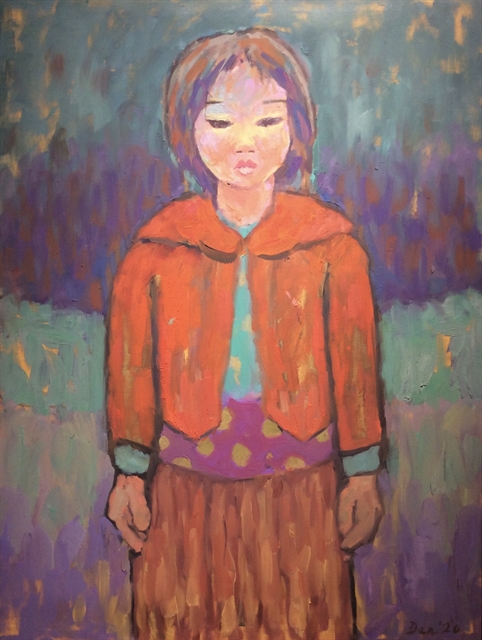
The Red Jacket: Village Girl in Northern Mountains, oil on canvas.
A couple of years ago, he rode my motorbike on what is called the northern loop, starting in Hà Giang City and going as far north as the province's Đồng Văn District before looping back down.
Several villages lie on the route around Đồng Văn and people’s daily lives have stayed largely the same for centuries.
“A group of children walking on a dirt road caught my eye, especially a little girl with uncombed hair and an unwashed face wearing a bright red handwoven jacket,” he recalled. “I took out my sketchbook and asked her to pose for me, but she was too shy. So I asked the friendliest girl in the group to pose. After I finished the sketch, I gave it to her, and this persuaded the girl in the red jacket to pose also.”
“She stood very seriously, very straight and stiff, but when I gave her the sketch a big smile lit up her face. I made sure I took photographs of the sketches I was giving them, to use later for a painting, along with some reference shots, especially for the colour.”
He then worked on the painting at home, which brought back memories of the villagers up in those mountains.
“Not an easy life even for the children, but one closer to family and nature,” he said.
Hambleton said he admired the strength inside Vietnamese people that he feels a lot in their everyday activities.
The American enjoys his life in Hà Nội and spends many of his mornings on the canvas.
He might make a sketch of a street, or of a person to work from, along with some reference photos to remind him of colour possibilities or details that weren’t included in the sketch.
At other times of the day, he looks for opportunities to sketch or take photographs that might be useful, whether in a cafe, on the street or elsewhere.
“I’ve tried setting up my easel and painting on the streets of Hà Nội, in the Old Quarter for example, but I’ve found that it attracts crowds and becomes too distracting for me to concentrate,” he said.
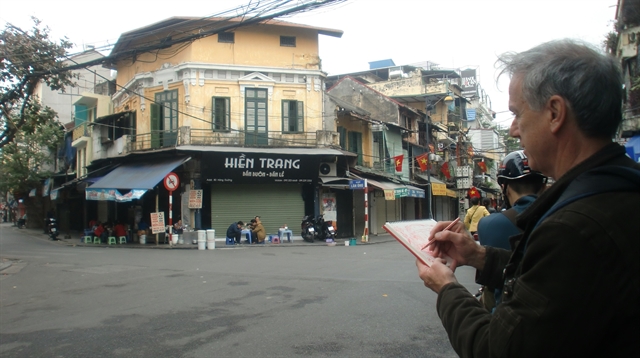
Hambleton sketches in a street in the Old Quarter of Hà Nội. Photo courtesy of the artist
That’s why on the first few days of Tết (Lunar New Year) he uses the time to sketch in the Old Quarter.
“For just those few days I can travel back in time to the Hà Nội of 40 or 50 years ago,” he said. VNS